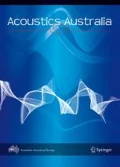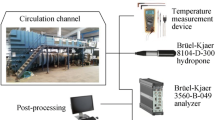Abstract
The flow field around a hydrophone generates self-noise which may contaminate the sound-field detection by a hydrophone. Hence, four hydrophone dome models are designed, and the flow field and sound field around them are compared. The RNG k–ε turbulence model is used for steady calculation. The results show that the four models have a fine diversion effect, and there is no obvious vortex and circumfluence because of them. The Curle model is used to simulate the sound source calculation of the hydrophone dome. The leading edge area of each model is found as the main noise source. The large eddy simulation/FW-H hybrid method is applied for the acoustic field calculation. The flow noise around the four models is studied. By summarizing the results of different models, the rules of flow noise around the hydrophone domes are analyzed. The suggestions for the hydrophone dome design are given based on the comprehensive evaluation of the noise generated by each hydrophone dome.













source distribution of each model












Similar content being viewed by others
References
Lighthill, M.J.: On sound generated aerodynamically I. Gernerall theory. Proc. R. Soc. A. 211, 564–587 (1952)
Lighthill, M.J.: On sound generated aerodynamically II. Turbulence as a source of sound. Proc. R. Soc. A. 222, 1–25 (1954)
Curle, N.: The influence of solid boundaries upon aerodynamic sound. Proc. R. Soc. A. 231, 505–514 (1955)
Ffowcs Williams, J.E., Hawking, D.L.: Sound generation by turbulence and surface in arbitrary motion. Philos. Trans. R. Soc. Lond. 264, 321–342 (1969)
Fu, H.P., Miao, G.P.: Application of LES method to flow noise calculation. J. Shanghai Jiaotong Univ. (Chin. Ed.) 43(8), 1307–1311 (2009)
Jiang, T., Ma, J., Zhang, M.: Prediction of submarine hydrodynamic noise by using large eddy simulation. J. Nav. Univ. Eng. 25(6), 64–68 (2013)
Han-Qin, Z., Ming, C., Guo-Cang, S.: Comparative study on the flow field and acoustic field simulation for noise prediction induced by the flow around a cylinder. Noise Vib. Control. 36(3), 26–31 (2016)
Liu, Z. J.: Study on hydrodynamic and flow noise characteristics of flow around rectangular cylinder. M. A, Thesis. Huazhong University of Science and Technology (2019)
Zhang, X.F., Liu, G.Q., Zhao, C., Zhang, T.: Research on acoustic properties of flow around underwater cylinders based on acoustic analogue. Ship Sci. Technol. 41(11), 120–124 (2019)
Li, Y., Chen, Z.W., Wang, X.N.: Flow / noise control of a rod-airfoil configuration using “natural rod-base blowing” : numerical experiments. Eur. J. Mech. B Fluids. 83, 99–33 (2020)
Li, Z.H., Qian, Z.D., Ji, B.: Transient cavitating flow structure and acoustic analysis of a hydrofoil with whalelike wavy leading edge. Appl. Math. Model. 85, 60–88 (2020)
Wang, Y.N., Hu, Z.W., Thompson, D.: Numerical investigations on the flow over cubes with rounded corners and the noise emitted. Comput. Fluids. 202, 104521 (2020)
Zheng, Z.C., Xu, Y.: Effects of reynolds stress on flow noise from vortex/hydrofoil interactions. J. Hydrodyn. 18(3), 381–385 (2006)
Ying, X. W.: Numerical simulation of sonar dome flow noise. M.A, Thesis. Harbin Engineering University (2007)
Chen, L., MacGillivray, I.: Characteristics of sound radiation by turbulent flow over a hydrofoil and a bare-hull SUBOFF. In: Australian Acoustical Society Conference, Acoustics 2011: Breaking New Ground. Gold Coast, Australia (2011)
Fu, S.F., Shang, D.J., Liu, Y.W.: The research on influences of dome materials on hydrodynamic noise inside bulbous bow. Tech. Acoust. 35(6), 197–200 (2016)
Lidtke, A.K., Turnock, S.R., Humphrey, V.F.: Characterisation of sheet cavity noise of a hydrofoil using the Ffowcs Williams-Hawkings acoustic analogy. Comput. Fluids 130, 8–23 (2016)
Yao, H., Zhang, H., Liu, H., Jiang, W.: Numerical study of flow-excited noise of a submarine with full appendages considering fluid structure interaction using the boundary element method. Eng. Anal. Boundary Elem. 77(4), 1–9 (2017)
Xu, Y., Xiong, Y., Huang, Z.: Numerical study on flow induced noise of flexible hydrofoil based on fluid structure interaction. J. Huazhong Univ. Sci. Technol. 45(11), 87–91 (2017)
Guo, C.Y., Zhang, Z.T., Cao, X.X., Wu, T.C.: Numerical and experimental studies of hydrodynamic performance of bionic leading-edge tubercle airfoil. J. Hydrodyn. 31, 1240–1249 (2019)
Pei, J., Liu, Y.W., Shang, D.J.: The method investigation on the flow-induced noise reduction from sonar domes by the leading-edge serrations. Tech. Acousics. 37(6), 425–426 (2019)
Khalid, M.S.U., Akhtar, I., Wu, B.X.: Quantification of flow noise produced by an oscillating hydrofoil. Ocean Eng. 171, 377–390 (2019)
Ozden, M.C., Gurkan, A.Y., Ozden, Y.A., Canyurt, T.G., Korkut, E.: Underwater radiated noise prediction for a submarine propeller in different flow conditions. Ocean Eng. 126(1), 488–500 (2016)
Brentner, K.S., Farassat, F.: An analytical comparison of the acoustic analogy and Kirschhoff formulations for moving surfaces. AIAA J. 36, 8 (1998)
Author information
Authors and Affiliations
Corresponding author
Additional information
Publisher's Note
Springer Nature remains neutral with regard to jurisdictional claims in published maps and institutional affiliations.
Rights and permissions
About this article
Cite this article
Guan, G., Zhuang, Z. & Yang, Q. The Effects of Hydrophone End-Cap Extension on the Flow-Generated Noise. Acoust Aust 49, 513–528 (2021). https://doi.org/10.1007/s40857-021-00247-0
Received:
Accepted:
Published:
Issue Date:
DOI: https://doi.org/10.1007/s40857-021-00247-0




